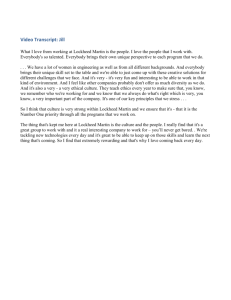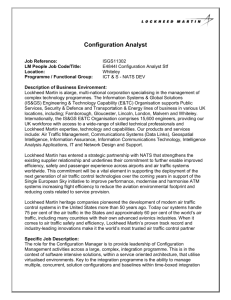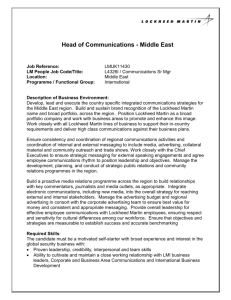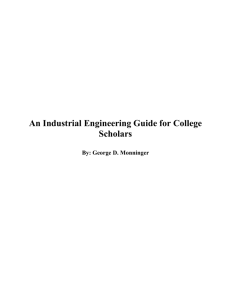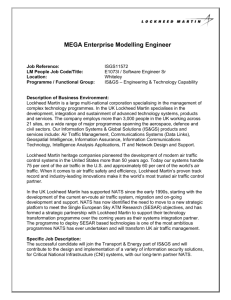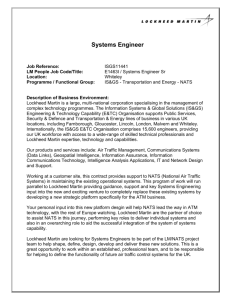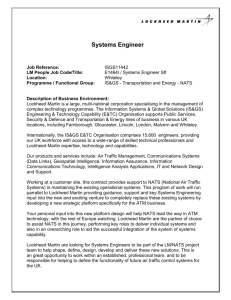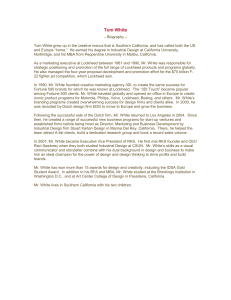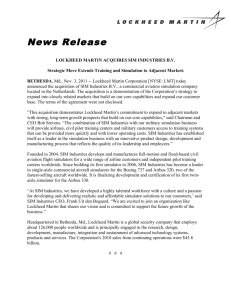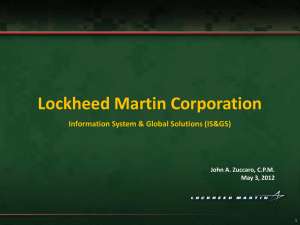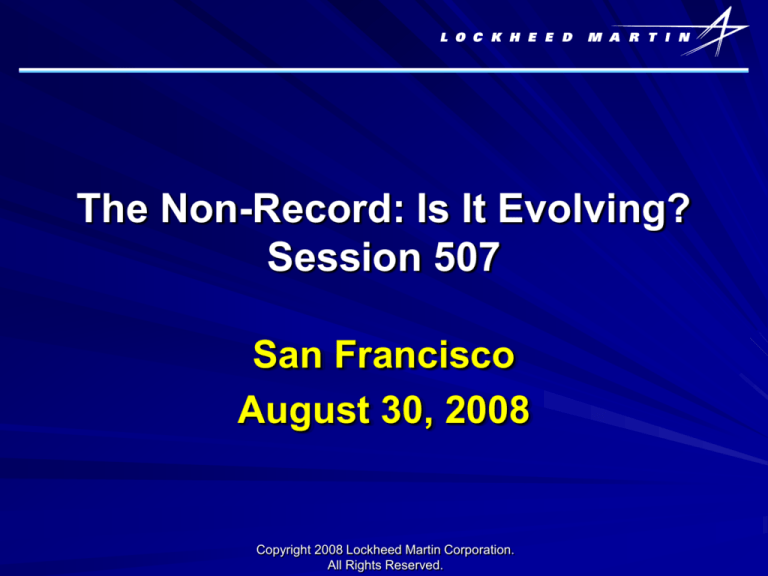
The Non-Record: Is It Evolving?
Session 507
San Francisco
August 30, 2008
Copyright 2008 Lockheed Martin Corporation.
All Rights Reserved.
Our Position
Business processes have changed as technology has been
applied to them, but our thinking about records and their
management has not kept up
Records are only a part of the information assets that support
business goals
Non records may exist, but the dichotomy is no longer useful
and, in fact, can be harmful
Our definition of what needs to be managed may be suboptimizing our organizations
A bigger, more pressing, problem than record/non record: Lack
of management of all information assets
Better to manage all information assets according to records
management principles (ISO 15489)
How this is done in the management of records and other
business assets depends on business needs
Copyright 2008 Lockheed Martin Corporation.
All Rights Reserved.
A View of the Organization Ecosystem
Copyright 2008 Lockheed Martin Corporation.
All Rights Reserved.
The RIM Process Model™
Leverage/Share/Repurpose
Search & Access
Create &
Capture
Use
Preserve
Assess
Manage
Copyright 2008 Lockheed Martin Corporation.
All Rights Reserved.
Recognize the
Share
RIM
Re-use
Hierarchy
Re-purpose
Exploit
of
Needs
Preservation Capability
Get Disposition Control
Get Intellectual Control
Get Physical Control
Drowning in the Digital Swamp
Copyright 2008 Lockheed Martin Corporation
All Rights Reserved
LEVEL SET
Copyright 2008 Lockheed Martin Corporation.
All Rights Reserved.
Definitions
Record (components of the definition)
All media
Made or received
In the course of the transaction of public business
Preserved or appropriate for preservation by that agency as
■ Evidence
■ For informational value
Other variations on the record definition
Non record (components of the definition)
Enumerated items
Anything that does not meet the definition of a record
Older items: Items not on a schedule
Unifying concepts
Copyright 2008 Lockheed Martin Corporation.
All Rights Reserved.
Questions
What is your understanding of the definitions of
record and non record?
Is the distinction useful and if so why?
What are your examples of non records?
Cited by NARA:
■ Information copies
Routing slips
■ Tickler files
Duplicate copies in the
same file
■ Catalogs, trade journals, etc., that require no action
■ Extra copies of printed materials where a record copy
exists
■ Artifacts with no evidential value.
Copyright 2008 Lockheed Martin Corporation.
All Rights Reserved.
Non Record Examples?
Some common ones we’ve heard. Is there a match?
Emails about lunch
Emails that replace phone calls
Desktop documents
Drafts
Comments/edits on
documents
GIS layers from other sources
Databases
Text messages / IM / Twitter
Web sites / Blogs / Wikis
Voice mail
Database search results
Information feeds
Surveillance videos
Mash-ups that mix
organizational information
and external information
Web sites caches
Software
Google alerts
Downloaded publications
Copyright 2008 Lockheed Martin Corporation.
All Rights Reserved.
Gray areas in the definitions
What is public business of, for which we need evidence?
What is a business transaction?
Who makes the decision on what is necessary to document
public business?
Record of what activity, for what purpose, in whose opinion?
Is everything that serves as evidence a record?
If we can’t agree on what a record is, how can we agree on
what is a non record?
Copyright 2008 Lockheed Martin Corporation.
All Rights Reserved.
Origins of the Non Record Approach
Objectives
Assumptions
Conditions
Driving forces
Constraints
Copyright 2008 Lockheed Martin Corporation.
All Rights Reserved.
Common misunderstandings/views
Record/non record may be OK in theory, but in
practice can be dangerous
Some common views in organizations
Records belong to the organization and I may be
responsible for them, but I don’t “own” them
(stewardship)
Non records are mine and I can set my own rules
(ownership)
There is no need to manage non records, even
though the management, from a volume
perspective, has been seen by RIM for decades
Copyright 2008 Lockheed Martin Corporation.
All Rights Reserved.
Why is this important?
Differing mental models on record/non record cause
confusion and hinder communication
As a mental model, it frames and constrains our thinking to
focus on a subset of information assets
Focus is on what information assets must be managed as
records rather than how to manage them. EPA example
Uneven application results in poorer records and increased
organization vulnerability
RMO and archivists are not included in conversations about
non record materials.
RMOs represent needs of the organization and
Archivists the needs of the larger community
Copyright 2008 Lockheed Martin Corporation.
All Rights Reserved.
WORKPLACE
CHANGES AND THEIR
IMPLICATIONS FOR
RECORDS AND
RECORDS
MANAGEMENT
Copyright 2008 Lockheed Martin Corporation.
All Rights Reserved.
Changes In The Workplace
Decline in the number of support staff
Storage issues change for staff
Accountability, transparency and privacy are driving forces
in recordkeeping
New multi media information streams
More documentation is being created
More litigation and regulation
Shift in costs
IT problems have shifted
Record/non record status is not always clear at creation, yet
many ERMS require it at creation
Copyright 2008 Lockheed Martin Corporation.
All Rights Reserved.
Potential Impact – Overall
If we ignored the record / non record question, it could:
Eliminate confusion and/or misunderstanding about record / non
record
Refocus discussion on management of information assets
rather than record status
Improved management
No threshold question barrier to prove record status
Improves intellectual control of all information assets
Reduce complexity and simplifiy management
all assets managed by same set of policies/procedures
Reduce confusion between records policy and legal and
compliance programs
Ensure RMOs and archivists a seat at the table for all
information assets
Copyright 2008 Lockheed Martin Corporation.
All Rights Reserved.
Impact on Ecosystem Components
Copyright 2008 Lockheed Martin Corporation.
All Rights Reserved.
Potential Impact On Archivists
Actual impact on archives is unclear since most records that
are affected are disposable.
What is your mandate for collection?
Activities of government/organization – focus on official
actions
Maintain record for accountability and transparency
Provide records for researchers
Where does the archival interest end
What is your greater fear:
Getting too much stuff
Getting too little
Do we want to require electronic records be
managed like paper?
Copyright 2008 Lockheed Martin Corporation.
All Rights Reserved.
Impact On Archival Appraisal
Much that many would consider non record will enrich the
understanding of decision making.
Disagreements among decision makers captured in email
Characterizations of other decision makers captured in email
Who is on the short list of people the decision maker
contacts regularly
Emails to spouse and/or love interests
Email as a telephone log
Do you want top-level officials (or their admins) making a
record/non record decision?
Do you want to give them a rationale to purge files?
How would you defend that to the public,
journalists, etc.
Copyright 2008 Lockheed Martin Corporation.
All Rights Reserved.
A Better Approach
Records are a part of the information assets that support
business goals
Records management must balance the records,
requirements for recordkeeping,
the risks poor management of the records poses
the business benefit good management offers, and
the available resources to identify what is “good
enough” records management for the organization
Manage everything using records management principles
(ISO 15489)
How this is done in the management of
records and other business assets depends
on business needs
Leverage/Share/Repurpose
Search & Access
Create &
Capture
Use
Preserve
Assess
Copyright 2008 Lockheed Martin Corporation.
All Rights Reserved.
Manage
The Next Phase
Archivists especially need to think about whether
the record/non record distinction is still useful.
If we maintain a narrow the definition of record we
risk losing a lot of the richness of the information
available that will allow us to provide a fuller
understanding of the past.
If we don’t do it nobody else will.
Copyright 2008 Lockheed Martin Corporation.
All Rights Reserved.
Feedback Loop
We’d appreciate your:
QUESTIONS
COMMENTS
SUGGESTIONS
Michael L. Miller
michael.2.miller@lmco.com
Office: 301-640-3678
L. Reynolds Cahoon
reynolds.cahoon@lmco.com
Office: 301-640-2844
Copyright 2008 Lockheed Martin Corporation.
All Rights Reserved.

